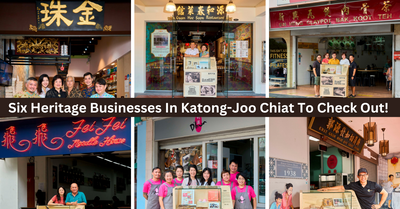In its first major revamp since its launch in 2016, the National Heritage Board (NHB)'s portal, Roots.sg, will now offer a brand-new look with fresh content and more features that improve user-friendliness, and keep current with digital trends.

Photo Credit: National Heritage Board
Relaunched as a one-stop, seamless and easy-to-use digital concierge, with a cultural ontology that brings together digital resources from across Singapore’s arts and culture scene, Roots.sg can now better enable the public to examine and explore Singapore's heritage.
The mobile-friendly website now makes greater use of artificial intelligence (AI) to power more accurate and relevant searches and recommendations, which would allow users to find information from the extensive catalogue easily.
The AI-powered search also provides more opportunities to explore lesser-known stories of Singapore’s history and heritage, by suggesting exploratory routes based on individual users’ interests. Casual visitors can use these suggested paths to delve deeper into Singapore’s heritage, while researchers will benefit from more effective and efficient information gathering.
Here are some of the new features and examples of content that can be found on the new Roots.sg:
1. Explore Singapore's Expansive National Collection
The upgraded AI-powered search of the revamped Roots.sg prompts visitors with recommendations to explore topics that are of interest to them more deeply, by offering quick links to related stories and other collections.
This makes it even easier to trawl through the website, which is home to over 100,000 artefacts and multimedia resources from the National Collection which have been digitalised and are easily accessible to all.
Visitors can explore the collections from the various museums and heritage institutions, which include the Asian Civilisations Museum, National Museum of Singapore, Peranakan Museum, Singapore Philatelic Museum, Indian Heritage Centre, Malay Heritage Centre, Sun Yat Sen Nanyang Memorial Hall, National Gallery Singapore, and Singapore Art Museum.
Some of the examples are as follows:
-
Malay Heritage Centre


Photo Credit: National Heritage Board
Visitors learning about Istana Kampong Gelam (now the Malay Heritage Centre) would find suggestions to check out objects in the collection like the Malay Shirt and Trousers, which was said to have been worn during the1860’s by Sultan Abdul Rahman, the last sovereign of the Riau-Lingga Sultanate.
-
Toa Payoh Dragon Playground


Photo Credit: National Heritage Board
Visitors reading about the Toa Payoh Dragon Playground would find recommendations, such as the HDB playground prototype drawings in the National Collection, and an article about playgrounds of the past.
2. Learn About Singapore's Intangible Cultural Heritage
With the revamped website's AI-powered recommendations, visitors exploring the Intangible Cultural Heritage (ICH) will also find suggestions of artefacts, places and people related to particular ICH elements, creating a seamless link between the different cultures, treasures, places and communities.
Roots.sg hosts a treasure trove of Singapore’s ICH, where visitors can learn more about living expressions inherited from our forefathers and passed down through the generations. NHB's ICH inventory seeks to identify and document the diverse elements of intangible cultural heritage that are practised in multicultural Singapore, and is grouped into six categories, namely social practices, rituals and festival events; knowledge and practices concerning nature and the universe; oral traditions and expressions; performing arts; traditional craftsmanship; and food heritage.
Some of the examples are as follows:
-
Zapin


Photo Credit: National Heritage Board
Visitors learning about zapin (one of the most popular dance and musical forms in traditional Malay performing arts) would find recommendations to check out objects in the National Collection, such as Gedok and mallet, drums used during traditional Malay music performances.
-
Making of Flower Garlands


Photo Credit: National Heritage Board
Visitors browsing the making of flower garlands would be recommended to check out an article about Thaipusam, because of the important role flower garlands play in Hindu religious practices.
3. Embark On Singapore's Heritage Trails

Photo Credit: National Heritage Board
Roots.sg is now integrated with Google Maps for seamless navigation, online and on the ground. Visitors can also filter places of heritage interest according to categories that include archaeological sites, places of worship, historic site markers and more.
Visitors can check out NHB’s 20 heritage trails to discover the lesser-known stories of Singapore's neighbourhoods, e.g.:
-
Hougang Heritage Trail



Photo Credit: National Heritage Board
Did you know that “Au Kang” means “at the back of the river” in both Teochew and Hokkien? The name is a reference to Sungei Serangoon at the end of Upper Serangoon Road, around which many Teochew-speaking inhabitants settled. Hougang is the Mandarin version of the phrase, introduced in 1980 for the new residential town which was being built at the time. While the old Teochew pronunciation has endured and the Teochew community continues to have a strong presence in the area, much has changed. A diverse mix of other communities and cultures has also flourished, and continues to accentuate the colourful character of one of Singapore’s oldest towns.
From tales of crocodile and pirate attacks, to Singapore’s first fast food restaurant in a housing estate, the Hougang Heritage Trail, consisting of 18 heritage sites with 10 trail markers, uncovers a treasure trove of lesser-known stories of an area steeped in history, over three thematic trail routes:
4. Explore Singapore's National Monuments

Photo Credit: National Heritage Board
The integration of Roots.sg with Google Maps has enabled fuss-free exploration of Singapore's National Monuments by enabling easy navigation on the ground, and online previews through Google Street View.
Visitors can learn about the National Monuments online before exploring them on-site, or virtually discover those that are not fully accessible to the public. National Monuments are buildings and sites that are accorded the highest level of protection in Singapore, and are an integral part of our built heritage.
Spread across the island, Singapore's 73 National Monuments have many rich, fascinating stories to tell, e.g.:
-
Tanjong Pagar Railway Station


Photo Credit: National Heritage Board
The Tanjong Pagar Railway Station used to be a passenger station for trains run by Malaysian rail operator Keretapi Tanah Melayu (KTM).
The three-storey station was designed by Serbian architect D S Petrovitch of architectural firm Swan & Maclaren, who drew upon a range of influences including the Art Deco, neoclassical and local styles of design.
The station was closed officially in July 2011, when the Sultan of Johor Ibrahim Iskandar piloted the last train’s departure from the station to Johor Baru Sentral in a ceremony witnessed by a large crowd.
For more than 60 years, the upper floors of the station housed a 34-room hotel operated by Lim Jit Chin and his family. In 1992, Lim received a letter from the Guinness Book of World Records acknowledging him as the second-longest serving hotel manager in the world.
The Tanjong Pagar Railway Station was gazetted as a National Monument in April 2011.




